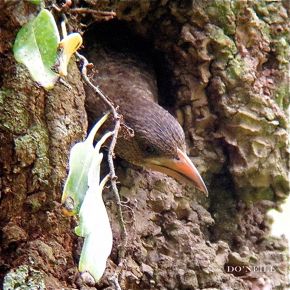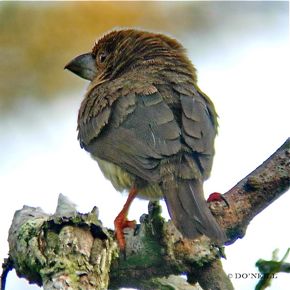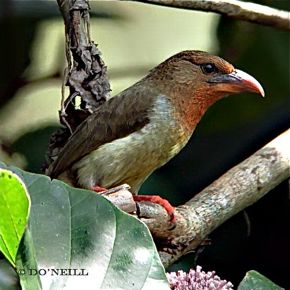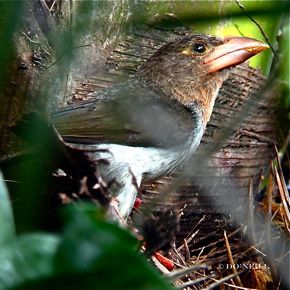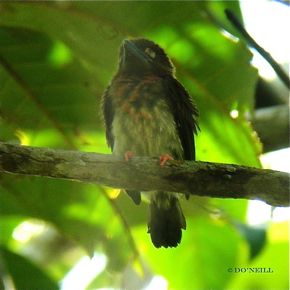“Brown Barbet (Calorhamphus fuliginosus), one of the 17 species of SE Asian Barbets is categorised as ‘Least Concern’ in the IUCN (International Union for Conservation of Nature) Red Data List of bird species in conjunction with Birdlife International – an agreed criteria based on the degree of threats of global bird population.
“Four subspecies are currently recognised based on geographical locations. They are:
Calorhamphus f. hayii: Malay Peninsula and Sumatra
Calorhamphus f. tertius: North Borneo (Sabah) only
Calorhamphus f. fuliginosus: Borneo except Sabah (Watershed boundary with Sarawak is South of Baram River)
Calorhamphus f. detersus: S. Myanmar& adjacent Peninsula Thailand
“There have been some recent taxonomic changes. Out of which, two species – C. f. hayii and C. f. fuliginosus from the split are being ear marked for status to ‘Near Threatened’ in the 2013 Data Red List update, following the application criteria. |Tobias et all (2010)|
“Not much details have been written in field guides about these birds. This have prompted me to dig into my bird photo gallery, to recall all those observations I’ve made in the field of the different places I have explored, to learn more about their different features and behaviour and perhaps add a bit more not described.
“A 5-part documentation series has been prepared for readers to add more dimensions into the behavioural study of Brown Barbets they rightly deserve. More importantly, specially prepared for mutual sharing, better understanding and further protection with discerning birders/photographers and citizen scientists, embracing the good practice of priority importance in bird conservation far above their personal interests.
“Let’s take a look at these splitting images I have put on parade of the Brown Barbets – a free standing class of its own with an attempt to describe them according to my photographs taken. Some of the comparisons baffle me in contrast to various field guides’ description.
(Lighting angles do play tricks to bird photography- the best reliable source is of course scientists/ornithologists who handle life specimens in bird descriptions, I do not doubt.)
“No: 1. C. f. hayii MALE
Front view adult: Chunky all black bill, darkish brown overall with whitish scaly streaks/mottled and near white below. Cinnamon brown iris in good light. Location: Mainland Penang Malaysia. Date: January 2012 (above left).
“No: 2. C. f. hayii FEMALE
Front view adult partner: Pinky bill. Similar in size and in plumage (above right).
Side view adult: Similar coral feet and legs and almost white undercarriage as in male (below left).
Location: Mainland Penang Malaysia. Date: March 2013.
“No: 3. C. f. hayii JUVENILE
Rear view: Male chick of above parents. Prominent pinkish bare skin around orbitals. Whitish base around mandibles (above right). Location: Mainland Penang Malaysia. Date: March 2013.
“No: 4. C. f. tertius MALE
Side view adult: Undescribed bicoloured upper mandible. A rufous frontal forehead that gradually fades into brown shades. Prominent rufous coloured chin and throat that terminate rather abruptly at the necklace line-chest/breast (above left). Under view: Light lemon wash over isolated blackish freckled blemishes on belly (above right). Location: Danum Valley Field Centre Sabah (N.Borneo). Date: May 2008.
“No: 5. C. f. tertius FEMALE
Side view adult. Prominent huge pink bill. Yellowish orbital skin around dark brown eyes (above left). Location: S.J.Resort Sandakan Sabah (North Borneo). Date: July 2009.
“No: 6. C. f. tertius JUVENILE
Side view: Horn coloured bill with black lining on both mandibles. Possibly juvenile male? Pale bare skin over orbitals with less rufous over upper chest area (above right). Location: Danum Valley Field Centre (N. Borneo). Date: May 2008.
“No: 7. C. f. fuliginosus MALE
Rear view: A prominent feature of adult male with pinkish bare skin around eyes. Blackish forehead blending into brown-rufous head also noted as in female (above left). Location: Similajau National Park, Bintulu, Sarawak, E. Malaysia. Date: September 2011.
“No: 8. C. f. fuliginosus FEMALE
Frontal view adult: Under sub-mandible is black extending to contrast with a heavy rufous throat and chest that gradually fades into lemon wash and creamish white towards vent (above right). Side view: An all pinky bill is represented in adult female (below left). Location: Lambir Hills N.Park, Miri Sarawak, E. Malaysia. Date: May 2011.
“No: 9. C. f. fuliginosus JUVENILE
Frontal view: Thick eyelids noted in this interesting male fledgling image. The whitish bill tip is still present and bodice showing characteristic frontal rufous feathering (above right). Location: Similajau National Park Bintulu, Sarawak, E. Malaysia. Date: September 2011.
“No: 10.C. f. detersus
“C. f. detersus calling twice… No appearance. This sub-species is having an identity crisis. So far, have not found any images in websites available to view this subspecies. It is for now believed and considered inseparable from C. f. hayii. Mmm…
“Myanmar is at its political watershed years and striving hard towards democracy. It will take time for the country to become more peaceful and politically stable, would perhaps f. detersus be ready to go on an avian parade.
“Perhaps too, ‘Miss Detersus-Junta’ is meant for the next generation of birders and photographers to pursue…”
Avian Writer Daisy O’Neill
Penang, Malaysia
20th April 2013
Copyright article and all images: Courtesy of Daisy O’Neill Bird Conservation Fund
References:
1. A Field Guide to the Birds of SEA by Craig Robson
2. The Birds of Borneo by B.E. Smythies. Revised by GWH Davison
3. The Birds of the Thai-Malay Peninsula by David R. Wells
4. BirdLife International Threatened Species Forum
5. Oriental Bird Images and the IBC



